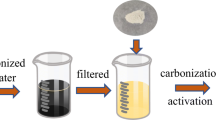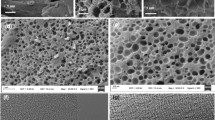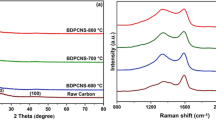Abstract
3D hierarchical porous carbon is widely accepted as an ideal electrode material for supercapacitor. But template method is a complicated and expensive way to produce material with such a special structure. In this article, a two-step activation method is proposed. Two activating agents: H3PO4 and KOH, are involved in preparation process. By applying this method, the carbonization time can be reduced, the carbonization temperature can be decreased, and the amount of activating agent can be cut down. The specific capacitance of optimal product can reach 366 F g−1 @ 1 A g−1, and even 326 F g−1 @ 10 A g−1 in a two-electrode system using 6 M KOH as electrolyte. The excellent structure endows the product with excellent rate performance (the specific capacitance decreases 18% when the current density increases for 100 times) and cycle performance (95% retention after 5000 cycles). Rational process is benefit for reducing resistance and improving double layer characteristic. The maximum power density can reach 191.90 kW kg−1, and energy density can reach 49.54 W h kg−1. This paper also explores the mechanism of two-step activation and provided a new idea to build 3D hierarchical porous structure by a simple and environmentally friendly way.






Similar content being viewed by others
References
P. Simon, Y. Gogotsi, B. Dunn, Where do batteries end and supercapacitors begin? Science 343(6176), 1210–1211 (2014)
J. Yan, Q. Wang, T. Wei, Z. Fan, Recent advances in design and fabrication of electrochemical supercapacitors with high energy densities. Adv. Energy Mater. 4(4), 1300816 (2014)
A. Burke, Ultracapacitors: why, how, and where is the technology. J. Power Sources 91(1), 37–50 (2000)
C. Long, T. Wei, J. Yan, L. Jiang, Z. Fan, Supercapacitors based on graphene-supported iron nanosheets as negative electrode materials. ACS Nano 7(12), 11325–11332 (2013)
A. Stein, Z. Wang, M.A. Fierke, Functionalization of porous carbon materials with designed pore architecture. Adv. Mater. 21(3), 265–293 (2009)
Y. Gogotsi, P. Simon, True performance metrics in electrochemical energy storage. Science 334(6058), 917–918 (2011)
J. Li, K. Han, S. Li, Porous carbons from Sargassum muticum prepared by H3PO4 and KOH activation for supercapacitors. J. Mater. Sci. 29(10), 8480–8491 (2018)
W.G. Pell, B.E. Conway, W.A. Adams, J. De Oliveira, Electrochemical efficiency in multiple discharge/recharge cycling of supercapacitors in hybrid EV applications. J. Power Sources 80(1–2), 134–141 (1999)
H. Sun, W. He, C. Zong, L. Lu, Template-free synthesis of renewable macroporous carbon via yeast cells for high-performance supercapacitor electrode materials. ACS Appl. Mater. Interfaces. 5(6), 2261–2268 (2013)
M. Biswal, A. Banerjee, M. Deo, S. Ogale, From dead leaves to high energy density supercapacitors. Energy Environ. Sci. 6(4), 1249–1259 (2013)
C. Long, L. Jiang, X. Wu, Y. Jiang, D. Yang, C. Wang et al., Facile synthesis of functionalized porous carbon with three-dimensional interconnected pore structure for high volumetric performance supercapacitors. Carbon 93, 412–420 (2015)
P. Hao, Z. Zhao, J. Tian, H. Li, Y. Sang, G. Yu et al., Hierarchical porous carbon aerogel derived from bagasse for high performance supercapacitor electrode. Nanoscale 6(20), 12120–12129 (2014)
T. Liu, F. Zhang, Y. Song, Y. Li, Revitalizing carbon supercapacitor electrodes with hierarchical porous structures. J. Mater. Chem. A 5(34), 17705–17733 (2017)
A. Volperts, G. Dobele, A. Zhurinsh, D. Vervikishko, E. Shkolnikov, J. Ozolinsh, Wood-based activated carbons for supercapacitor electrodes with a sulfuric acid electrolyte. New Carbon Mater. 32(4), 319–326 (2017)
D.W. Wang, F. Li, M. Liu, G.Q. Lu, H.M. Cheng, 3D aperiodic hierarchical porous graphitic carbon material for high-rate electrochemical capacitive energy storage. Angew. Chem. 120(2), 379–382 (2008)
Y. Li, Z. Li, P.K. Shen, Simultaneous formation of ultrahigh surface area and three-dimensional hierarchical porous graphene-like networks for fast and highly stable supercapacitors. Adv. Mater. 25(17), 2474–2480 (2013)
Z. Fan, Y. Liu, J. Yan, G. Ning, Q. Wang, T. Wei et al., Template-directed synthesis of pillared-porous carbon nanosheet architectures: high-performance electrode materials for supercapacitors. Adv. Energy Mater. 2(4), 419–424 (2012)
Q. Wang, J. Yan, Y. Wang, G. Ning, Z. Fan, T. Wei et al., Template synthesis of hollow carbon spheres anchored on carbon nanotubes for high rate performance supercapacitors. Carbon 52, 209–218 (2013)
J.F. González, S. Román, C.M. González-García, J.V. Nabais, A.L. Ortiz, Porosity development in activated carbons prepared from walnut shells by carbon dioxide or steam activation. Ind. Eng. Chem. Res. 48(16), 7474–7481 (2009)
A. Anson, J. Jagiello, J.B. Parra, M.L. Sanjuan, A.M. Benito, W.K. Maser et al., Porosity, surface area, surface energy, and hydrogen adsorption in nanostructured carbons. J. Phys. Chem. B 108(40), 15820–15826 (2004)
J.S. Cha, J.-C. Choi, J.H. Ko, Y.-K. Park, S.H. Park, K.-E. Jeong et al., The low-temperature SCR of NO over rice straw and sewage sludge derived char. Chem. Eng. J. 156(2), 321–327 (2010)
K. Fu, Q. Yue, B. Gao, Y. Wang, Q. Li, Activated carbon from tomato stem by chemical activation with FeCl2. Colloids Surf. A 529, 842–849 (2017)
Q. Wen, C. Li, Z. Cai, W. Zhang, H. Gao, L. Chen et al., Study on activated carbon derived from sewage sludge for adsorption of gaseous formaldehyde. Bioresour. Technol. 102(2), 942–947 (2011)
K. Fu, Q. Yue, B. Gao, Y. Sun, L. Zhu, Preparation, characterization and application of lignin-based activated carbon from black liquor lignin by steam activation. Chem. Eng. J. 228, 1074–1082 (2013)
M.J. Ahmed, S.K. Theydan, Microporous activated carbon from Siris seed pods by microwave-induced KOH activation for metronidazole adsorption. J. Anal. Appl. Pyrolysis 99, 101–109 (2013)
R.H. Hesas, A. Arami-Niya, W.M.A.W. Daud, J. Sahu, Comparison of oil palm shell-based activated carbons produced by microwave and conventional heating methods using zinc chloride activation. J. Anal. Appl. Pyrolysis 104, 176–184 (2013)
H. Liu, J. Zhang, C. Zhang, N. Bao, C. Cheng, Activated carbons with well-developed microporosity and high surface acidity prepared from lotus stalks by organophosphorus compounds activations. Carbon 60, 289–291 (2013)
T.-H. Liou, Development of mesoporous structure and high adsorption capacity of biomass-based activated carbon by phosphoric acid and zinc chloride activation. Chem. Eng. J. 158(2), 129–142 (2010)
J.I. Hayashi, M. Uchibayashi, T. Horikawa, K. Muroyama, V.G. Gomes, Synthesizing activated carbons from resins by chemical activation with K2CO3. Carbon 40(15), 2747–2752 (2002)
G. Dobele, T. Dizhbite, G. Rossinskaja, G. Telysheva, D. Meier, S. Radtke et al., Pre-treatment of biomass with phosphoric acid prior to fast pyrolysis: a promising method for obtaining 1, 6-anhydrosaccharides in high yields. J. Anal. Appl. Pyrolysis 68, 197–211 (2003)
Y. Gao, Q. Yue, B. Gao, Y. Sun, W. Wang, Q. Li et al., Preparation of high surface area-activated carbon from lignin of papermaking black liquor by KOH activation for Ni (II) adsorption. Chem. Eng. J. 217, 345–353 (2013)
M.A. Islam, M. Ahmed, W. Khanday, M. Asif, B. Hameed, Mesoporous activated coconut shell-derived hydrochar prepared via hydrothermal carbonization-NaOH activation for methylene blue adsorption. J. Environ. Manag. 203, 237–244 (2017)
L. Qian, B. Chen, Interactions of aluminum with biochars and oxidized biochars: implications for the biochar aging process. J. Agric. Food Chem. 62(2), 373–380 (2014)
H. Jin, S. Capareda, Z. Chang, J. Gao, Y. Xu, J. Zhang, Biochar pyrolytically produced from municipal solid wastes for aqueous As (V) removal: adsorption property and its improvement with KOH activation. Bioresour. Technol. 169, 622–629 (2014)
H. Xia, Y.S. Meng, G. Yuan, C. Cui, L. Lu, A symmetric RuO2/RuO2 supercapacitor operating at 16 V by using a neutral aqueous electrolyte. Electrochem. Solid-State Lett. 15(4), A60–A63 (2012)
P. Carrot, R. Roberts, K. Sing, Adsorption of nitrogen by porous and non-porous carbons. Carbon 25(1), 59 (1987)
J. Rouquerol, D. Avnir, C. Fairbridge, D. Everett, J. Haynes, N. Pernicone et al., Physical and biophysical chemistry division commission on colloid and surface chemistry including catalysis. Pure Appl. Chem. 66, 1739–1758 (1994)
J. Rouquerol, D. Avnir, C. Fairbridge, D. Everett, J. Haynes, N. Pernicone et al., Recommendations for the characterization of porous solids (Technical Report). Pure Appl. Chem. 66(8), 1739–1758 (1994)
Y. Zhang, S. Liu, X. Zheng, X. Wang, Y. Xu, H. Tang et al., Biomass organs control the porosity of their pyrolyzed carbon. Adv. Funct. Mater. 27(3), 1604687 (2017)
A. Elmouwahidi, E. Bailón-García, A.F. Pérez-Cadenas, F.J. Maldonado-Hódar, F. Carrasco-Marín, Activated carbons from KOH and H3PO4-activation of olive residues and its application as supercapacitor electrodes. Electrochim. Acta 229, 219–228 (2017)
C. Chen, D. Yu, G. Zhao, B. Du, W. Tang, L. Sun et al., Three-dimensional scaffolding framework of porous carbon nanosheets derived from plant wastes for high-performance supercapacitors. Nano Energy 27, 377–389 (2016)
M. Yu, Y. Han, J. Li, L. Wang, CO 2-activated porous carbon derived from cattail biomass for removal of malachite green dye and application as supercapacitors. Chem. Eng. J. 317, 493–502 (2017)
J. Gamby, P. Taberna, P. Simon, J. Fauvarque, M. Chesneau, Studies and characterisations of various activated carbons used for carbon/carbon supercapacitors. J. Power Sources 101(1), 109–116 (2001)
S. Li, K. Han, P. Si, J. Li, C. Lu, High–performance activated carbons prepared by KOH activation of gulfweed for supercapacitors. Int. J. Electrochem. Sci. 13, 1728–1743 (2018)
C. Mao, Preparation and performance of activated carbon materials for supercapacitors, School of Energy & Environmental (Southeast University, Nanjing, 2015)
S. Bose, T. Kuila, A.K. Mishra, R. Rajasekar, N.H. Kim, J.H. Lee, Carbon-based nanostructured materials and their composites as supercapacitor electrodes. J. Mater. Chem. 22(3), 767–784 (2012)
C. Portet, G. Yushin, Y. Gogotsi, Electrochemical performance of carbon onions, nanodiamonds, carbon black and multiwalled nanotubes in electrical double layer capacitors. Carbon 45(13), 2511–2518 (2007)
J. Zhou, J. Lian, L. Hou, J. Zhang, H. Gou, M. Xia et al., Ultrahigh volumetric capacitance and cyclic stability of fluorine and nitrogen co-doped carbon microspheres. Nat. Commun. 6, 8503 (2015)
G. Li, Y. Li, X. Qian, H. Liu, H. Lin, N. Chen et al., Construction of tubular molecule aggregations of graphdiyne for highly efficient field emission. J. Phys. Chem. C 115(6), 2611–2615 (2011)
J. Yan, Q. Wang, T. Wei, L. Jiang, M. Zhang, X. Jing et al., Template-assisted low temperature synthesis of functionalized graphene for ultrahigh volumetric performance supercapacitors. ACS Nano 8(5), 4720–4729 (2014)
Z. Li, Z. Xu, H. Wang, J. Ding, B. Zahiri, C.M. Holt et al., Colossal pseudocapacitance in a high functionality–high surface area carbon anode doubles the energy of an asymmetric supercapacitor. Energy Environ. Sci. 7(5), 1708–1718 (2014)
Acknowledgements
The authors would like to acknowledge funding support by the Natural Science Foundation of Shandong, China (ZR2017MEE010), and the Fundamental Research Funds of Shandong University (2016JC005).
Author information
Authors and Affiliations
Corresponding author
Additional information
Publisher's Note
Springer Nature remains neutral with regard to jurisdictional claims in published maps and institutional affiliations.
Electronic supplementary material
Below is the link to the electronic supplementary material.
Rights and permissions
About this article
Cite this article
Li, J., Han, K., Qi, J. et al. Biomass-derived 3D hierarchical porous carbon by two-step activation method for supercapacitor. J Mater Sci: Mater Electron 30, 19415–19425 (2019). https://doi.org/10.1007/s10854-019-02303-y
Received:
Accepted:
Published:
Issue Date:
DOI: https://doi.org/10.1007/s10854-019-02303-y




